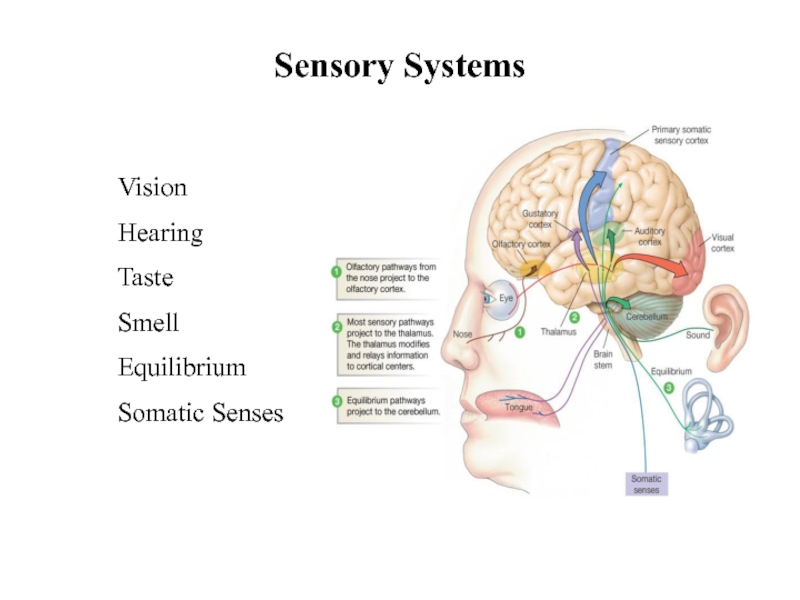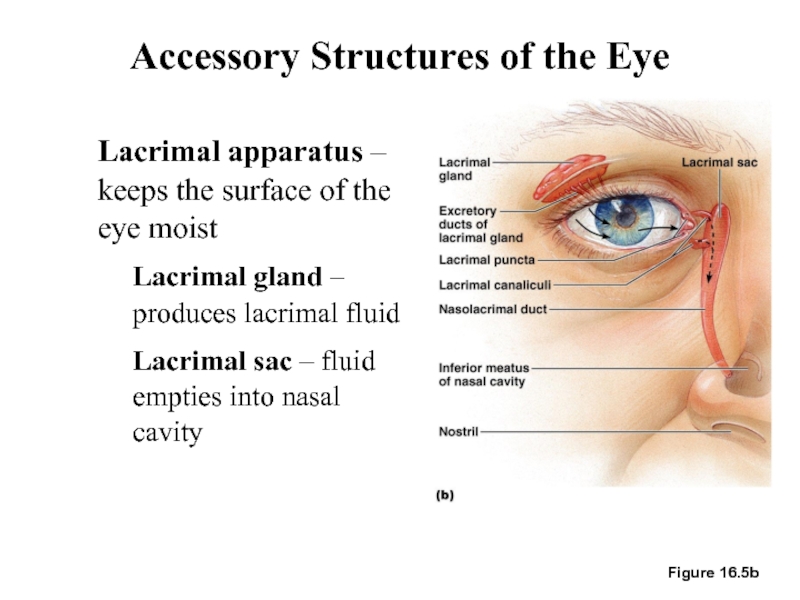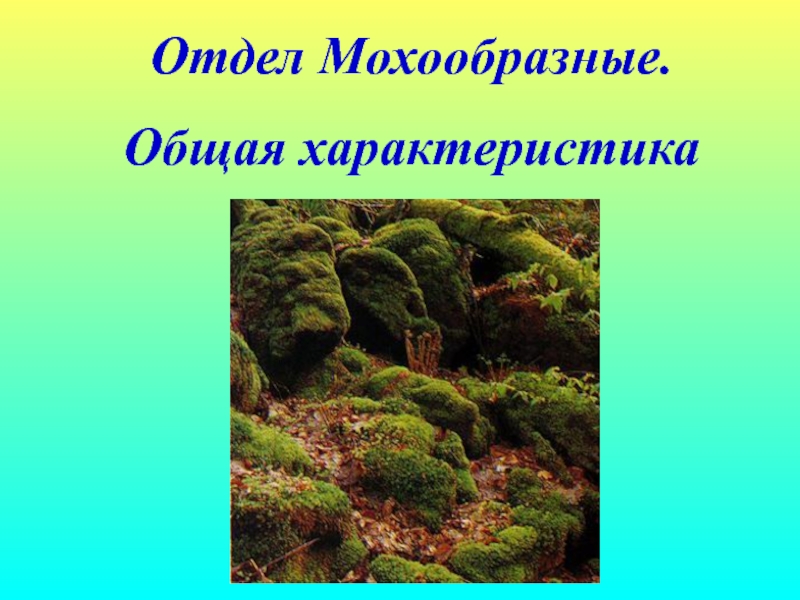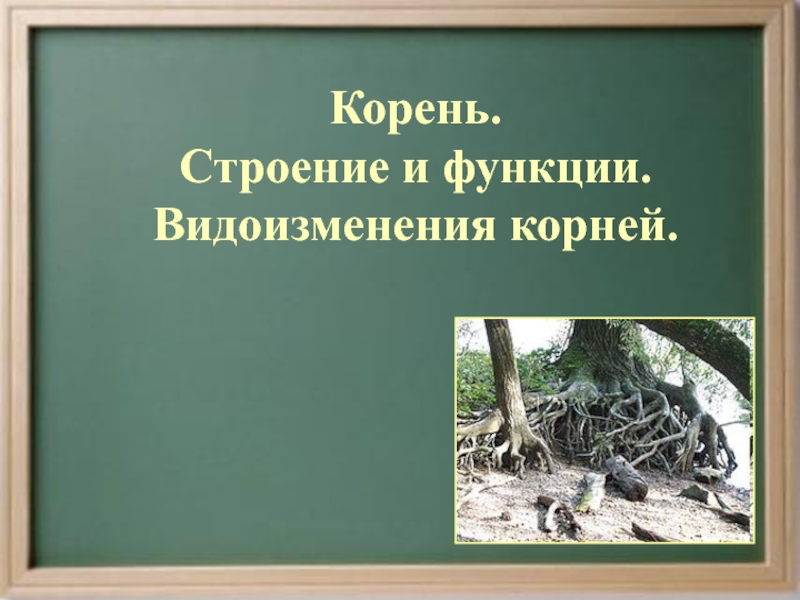- Главная
- Разное
- Дизайн
- Бизнес и предпринимательство
- Аналитика
- Образование
- Развлечения
- Красота и здоровье
- Финансы
- Государство
- Путешествия
- Спорт
- Недвижимость
- Армия
- Графика
- Культурология
- Еда и кулинария
- Лингвистика
- Английский язык
- Астрономия
- Алгебра
- Биология
- География
- Детские презентации
- Информатика
- История
- Литература
- Маркетинг
- Математика
- Медицина
- Менеджмент
- Музыка
- МХК
- Немецкий язык
- ОБЖ
- Обществознание
- Окружающий мир
- Педагогика
- Русский язык
- Технология
- Физика
- Философия
- Химия
- Шаблоны, картинки для презентаций
- Экология
- Экономика
- Юриспруденция
Sensory systems презентация
Содержание
- 1. Sensory systems
- 2. Sensory Systems Somatic sensory General –
- 3. Stimulus - energy source Internal External Receptors
- 4. Sensory Pathways Stimulus as physical energy ?
- 5. Classification by Function (Stimuli) Mechanoreceptors – respond
- 6. Classification by Location Exteroceptors – sensitive to
- 7. Classification by Structure
- 8. General somatic – include touch, pain, vibration,
- 9. Somatic Receptors Divided into two groups
- 10. Free Nerve Endings Abundant in epithelia and
- 11. Encapsulated Nerve Endings Meissner’s corpuscles Spiraling
- 12. Encapsulated Nerve Endings - Proprioceptors Monitor
- 13. Muscle Spindle & Golgi Tendon Organ
- 14. Special Senses Figure 10-4: Sensory pathways Taste,
- 15. Anatomy of the Eyeball Function of the
- 16. The Fibrous Layer Most external layer of
- 17. The Vascular Layer Middle layer consists of
- 18. The Vascular Layer Choroid - vascular layer
- 19. The Inner Layer (Retina) Retina is the
- 20. Photoreceptors Two main types Rod cells
- 21. Regional Specializations of the Retina Ora serrata
- 22. The Lens A thick, transparent, biconvex disc
- 23. The Eye as an Optical Device Structures
- 24. Internal Chambers and Fluids Figure 16.8
- 25. Internal Chambers and Fluids Anterior segment Divided
- 26. Internal Chambers and Fluids The lens and
- 27. Accessory Structures of the Eye Eyebrows –
- 28. Accessory Structures of the Eye Lacrimal apparatus
- 29. Extrinsic Eye Muscles Figure 16.6a, b Six
- 30. Visual Pathways to the Cerebral Cortex Pathway
- 31. Optic nerve Optic chiasm Optic tract Thalamus
- 32. The Ear: Hearing and Equilibrium The ear
- 33. The Outer (External) Ear Auricle (pinna) -
- 34. The Middle Ear The tympanic cavity
- 35. Figure 16.17 The Middle Ear Ear ossicles
- 36. The Inner (Internal) Ear Inner ear –
- 37. The Membranous Labyrinth Figure 16.18 Membranous labyrinth
- 38. The Cochlea A spiraling chamber in the
- 39. The Cochlea The cochlear duct (scala media)
- 40. The Cochlea The cochlear duct (scala media)
- 41. The Role of the Cochlea in Hearing Figure 16.20
- 42. Auditory Pathway from the Organ of Corti
- 43. The Vestibule Utricle and saccule – suspended
- 44. Anatomy and Function of the Maculae Figure 16.21b
- 45. The Semicircular Canals Lie posterior and lateral
- 46. The Semicircular Canals Semicircular duct – snakes
- 47. Structure and Function of the Crista Ampullaris Figure 16.22b
- 48. The Chemical Senses: Taste and Smell Taste
- 49. Taste – Gustation Taste receptors Occur in
- 50. Taste Buds Collection of 50 –100 epithelial
- 51. Taste Sensation and the Gustatory Pathway Four
- 52. Gustatory Pathway from Taste Buds Figure 16.2
- 53. Olfactory epithelium with olfactory receptors, supporting cells,
- 54. Olfactory Receptors Bipolar sensory neurons located within
Слайд 2Sensory Systems
Somatic sensory
General – transmit impulses from skin, skeletal muscles,
Special senses - hearing, balance, vision
Visceral sensory
Transmit impulses from visceral organs
Special senses - olfaction (smell), gustation (taste)
Слайд 3Stimulus - energy source
Internal
External
Receptors
Sense organs - structures specialized to respond
Transducers - stimulus energy converted into action potentials
Conduction
Afferent pathway
Nerve impulses to the CNS
Translation
CNS integration and information processing
Sensation and perception – your reality
Properties of Sensory Systems
Слайд 4Sensory Pathways
Stimulus as physical energy ? sensory receptor acts as a
Stimulus > threshold ? action potential to CNS
Integration in CNS ? cerebral cortex or acted on subconsciously
Слайд 5Classification by Function (Stimuli)
Mechanoreceptors – respond to touch, pressure, vibration, stretch,
Thermoreceptors – sensitive to changes in temperature
Photoreceptors – respond to light energy (e.g., retina)
Chemoreceptors – respond to chemicals (e.g., smell, taste, changes in blood chemistry)
Nociceptors – sensitive to pain-causing stimuli
Osmoreceptors – detect changes in concentration of solutes, osmotic activity
Baroreceptors – detect changes in fluid pressure
Слайд 6Classification by Location
Exteroceptors – sensitive to stimuli arising from outside the
Located at or near body surfaces
Include receptors for touch, pressure, pain, and temperature
Interoceptors – (visceroceptors) receive stimuli from internal viscera
Monitor a variety of stimuli
Proprioceptors – monitor degree of stretch
Located in musculoskeletal organs
Слайд 8General somatic – include touch, pain, vibration, pressure, temperature
Proprioceptive – detect
Somatic Senses
Слайд 9Somatic Receptors
Divided into two groups
Free or Unencapsulated nerve endings
Encapsulated nerve endings
Слайд 10Free Nerve Endings
Abundant in epithelia and underlying connective tissue
Nociceptors - respond
Thermoreceptors - respond to temperature
Two specialized types of free nerve endings
Merkel discs – lie in the epidermis, slowly adapting receptors for light touch
Hair follicle receptors – Rapidly adapting receptors that wrap around hair follicles
Слайд 11Encapsulated Nerve Endings
Meissner’s corpuscles
Spiraling nerve ending surrounded by Schwann cells
Occur
Rapidly adapting receptors for discriminative touch
Pacinian corpuscles
Single nerve ending surrounded by layers of flattened Schwann cells
Occur in the hypodermis
Sensitive to deep pressure – rapidly adapting receptors
Ruffini’s corpuscles
Located in the dermis and respond to pressure
Monitor continuous pressure on the skin – adapt slowly
Слайд 12Encapsulated Nerve Endings - Proprioceptors
Monitor stretch in locomotory organs
Three types
Muscle spindles – monitors the changing length of a muscle, imbedded in the perimysium between muscle fascicles
Golgi tendon organs – located near the muscle-tendon junction, monitor tension within tendons
Joint kinesthetic receptors - sensory nerve endings within the joint capsules, sense pressure and position
Слайд 14Special Senses
Figure 10-4: Sensory pathways
Taste, smell, sight, hearing, and balance
Localized –
Receptors are not free endings of sensory neurons but specialized receptor cells
Слайд 15Anatomy of the Eyeball
Function of the eyeball
Protect and support the photoreceptors
Gather,
External walls – composed of three tunics (layers)
Internal cavity – contains fluids (humors)
Слайд 16The Fibrous Layer
Most external layer of the eyeball
Cornea
Anterior one-sixth of the
Composed of stratified Squamous externally, simple squamous internally
Refracts (bends) light
Sclera
Posterior five-sixths of the tunic
White, opaque region composed of dense irregular connective tissue Provides shape and an anchor for eye muscles,
Scleral venous sinus – allows aqueous humor to drain
Слайд 17The Vascular Layer
Middle layer consists of choroid, ciliary body, and iris
Iris and Pupil
Composed of smooth muscle, melanocytes, and blood vessels that forms the colored portion of the eye.
Function: It regulates the amount of light entering the eye through the pupil.
It is attached to the ciliary body.
Pupil is the opening in center of iris through which light enters the eye
Ciliary body
Composed of a ring of muscle called ciliary muscle and ciliary processes which are folds located at the posterior surface of ciliary bodies
Suspensory ligaments attach to these processes
Function: secretes the aqueous humor
The suspensory ligaments position the lens so that light passing through the pupil passes through the center of the lens of the eye.
Слайд 18The Vascular Layer
Choroid - vascular layer in the wall of the
Dark brown (pigmented) membrane with melanocytes that lines most of the internal surface of the sclera. Has lots of blood vessels
Lines most of the interior of the sclera.
Extends from the ciliary body to the lens.
Corresponds to arachnoid and pia mater
Functions:
Delivers oxygen and nutrients to the retina.
Absorb light rays so that the light rays are not reflected within the eye
Слайд 19The Inner Layer (Retina)
Retina is the innermost layer of the eye
The retina contains 2 layers:
Pigmented layer made of a single layer of melanocytes, absorbs light after it passes through the neural layer
Neural layer – sheet of nervous tissue, contains three main types of neurons
Photoreceptor cells
Bipolar cells
Ganglion cells
Слайд 20Photoreceptors
Two main types
Rod cells
More sensitive to light
Allow vision in
In periphery
Cone cells
Operate best in bright light
High-acuity
Color vision – blue, green, red cones
Concentrated in fovea
Слайд 21Regional Specializations of the Retina
Ora serrata retinae
Neural layer ends at
Pigmented layer covers ciliary body and posterior surface of the iris
Macula lutea – contains mostly cones
Fovea centralis – contains only cones
Region of highest visual acuity
Optic disc – blind spot
Слайд 22The Lens
A thick, transparent, biconvex disc
Held in place by its ciliary
Lens epithelium – covers anterior surface of the lens
Слайд 23The Eye as an Optical Device
Structures in the eye bend light
Light rays converge on the retina at a single focal point
Light bending structures (refractory media)
The lens, cornea, and humors
Accommodation – curvature of the lens is adjustable
Allows for focusing on nearby objects
Слайд 25Internal Chambers and Fluids
Anterior segment
Divided into anterior and posterior chambers
Anterior chamber
Posterior chamber – between the iris and lens
Filled with aqueous humor
Renewed continuously
Formed as a blood filtrate
Supplies nutrients to the lens and cornea
Слайд 26Internal Chambers and Fluids
The lens and ciliary zonules divide the eye
Posterior segment (cavity)
Filled with vitreous humor - clear, jelly-like substance
Transmits light
Supports the posterior surface of the lens
Helps maintain intraocular pressure
Слайд 27Accessory Structures of the Eye
Eyebrows – coarse hairs on the superciliary
Eyelids (palpebrae)
Separated by the palpebral fissure
Meet at the medial and lateral angles (canthi)
Conjunctiva – transparent mucous membrane
Palpebral conjunctiva
Bulbar (ocular) conjunctiva
Conjunctival sac
Moistens the eye
Figure 16.5a
Слайд 28Accessory Structures of the Eye
Lacrimal apparatus – keeps the surface of
Lacrimal gland – produces lacrimal fluid
Lacrimal sac – fluid empties into nasal cavity
Figure 16.5b
Слайд 29Extrinsic Eye Muscles
Figure 16.6a, b
Six muscles that control movement of the
Originate in the walls of the orbit
Insert on outer surface of the eyeball
Слайд 30Visual Pathways to the Cerebral Cortex
Pathway begins at the retina
Light activates
Photoreceptors signal bipolar cells
Bipolar cells signal ganglion cells
Axons of ganglion cells exit eye as the optic nerve
Слайд 31Optic nerve
Optic chiasm
Optic tract
Thalamus
Visual cortex
Other pathways include the midbrain and
Vision Integration / Pathway
Figure 10-29b, c: Neural pathways for vision and the papillary reflex
Слайд 32The Ear: Hearing and Equilibrium
The ear – receptor organ for hearing
Composed of three main regions
Outer ear – functions in hearing
Middle ear – functions in hearing
Inner ear – functions in both hearing and equilibrium
Слайд 33The Outer (External) Ear
Auricle (pinna) - helps direct sounds
External acoustic meatus
Lined
Contains hairs, sebaceous glands, and ceruminous glands
Tympanic membrane
Forms the boundary between the external and middle ear
Слайд 34The Middle Ear
The tympanic cavity
A small, air-filled space
Located within
Medial wall is penetrated by
Oval window
Round window
Pharyngotympanic tube (auditory or eustachian tube) - Links the middle ear and pharynx
Слайд 35Figure 16.17
The Middle Ear
Ear ossicles – smallest bones in the body
Malleus
Incus – between the malleus and stapes
Stapes – vibrates against the oval window
Слайд 36The Inner (Internal) Ear
Inner ear – also called the labyrinth
Bony labyrinth
Semicircular canals
Vestibule
Cochlea
Bony labyrinth is filled with perilymph
Слайд 37The Membranous Labyrinth
Figure 16.18
Membranous labyrinth - series of membrane-walled sacs and
Fit within the bony labyrinth
Consists of three main parts
Semicircular ducts
Utricle and saccule
Cochlear duct
Filled with a clear fluid – endolymph
Слайд 38The Cochlea
A spiraling chamber in the bony labyrinth
Coils around a pillar
Spiral lamina – a spiral of bone in the modiolus
The cochlear nerve runs through the core of the modiolus
Слайд 39The Cochlea
The cochlear duct (scala media) – contains receptors for hearing
Lies
The scala vestibuli
The scala tympani
The vestibular membrane – the roof of the cochlear duct
The basilar membrane – the floor of the cochlear duct
Слайд 40The Cochlea
The cochlear duct (scala media) – contains receptors for hearing
Organ
Consists of hair cells (receptor cells)
Слайд 42Auditory Pathway from the Organ of Corti
The ascending auditory pathway
Transmits
Figure 16.23
Слайд 43The Vestibule
Utricle and saccule – suspended in perilymph
Two egg-shaped parts
House the macula – a spot of sensory epithelium
Macula – contains receptor cells
Monitor the position of the head when the head is still
Contains columnar supporting cells
Receptor cells – called hair cells
Synapse with the vestibular nerve
Слайд 45The Semicircular Canals
Lie posterior and lateral to the vestibule
Anterior and posterior
Lateral semicircular canal lies in the horizontal plane
Слайд 46The Semicircular Canals
Semicircular duct – snakes through each semicircular canal
Membranous ampulla
Houses a structure called a crista ampullaris
Cristae contain receptor cells of rotational acceleration
Epithelium contains supporting cells and receptor hair cells
Слайд 48The Chemical Senses: Taste and Smell
Taste – gustation
Smell – olfaction
Receptors
Respond to chemicals
Слайд 49Taste – Gustation
Taste receptors
Occur in taste buds
Most are found on the
Located within tongue papillae
Two types of papillae (with taste buds)
Fungiform papillae
Circumvallate papillae
Слайд 50Taste Buds
Collection of 50 –100 epithelial cells
Contain three major cell types
Supporting cells
Gustatory cells
Basal cells
Contain long microvilli – extend through a taste pore
Слайд 51Taste Sensation and the Gustatory Pathway
Four basic qualities of taste
Sweet, sour,
A fifth taste – umami, “deliciousness”
No structural difference among taste buds
Слайд 52Gustatory Pathway from Taste Buds
Figure 16.2
Taste information reaches the cerebral cortex
Primarily
Some taste information through the vagus nerve (X)
Sensory neurons synapse in the medulla
Located in the solitary nucleus
Слайд 53Olfactory epithelium with olfactory receptors, supporting cells, basal cells
Olfactory receptors are
Surfaces are coated with secretions from olfactory glands
Olfactory reception involves detecting dissolved chemicals as they interact with odorant binding proteins
Smell (Olfaction)
Слайд 54Olfactory Receptors
Bipolar sensory neurons located within olfactory epithelium
Dendrite projects into
Axon projects directly up into olfactory bulb of cerebrum
Olfactory bulb projects to olfactory cortex, hippocampus, and amygdaloid nuclei



























































